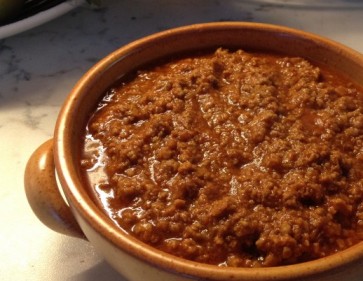In The Sopranos's episode “Commendatori”, Tony Soprano and his friends take a business trip to Naples in order to conduct an important deal. In the hotel restaurant, Paulie Gualtieri is served a plate of spaghetti with squid ink. Although he is Italian by origin, Paulie was born in New Jersey and he looks at the dish in semi-disgust. He asks the Italian waiter to bring him some “macaroni and gravy”. The Neapolitan waiter, bewildered, asks the mobster what gravy means, whereby Paulie explains:
Paulie : Gravy, gravy. Tomato sauce!
A camorrista translates it as “pommarola” to the waiter. Here's the video clip of the scene on Youtube.
This isn't the first time I've heard American movies or TV series use the term gravy for the Italianissimo pommarola. But I've never heard it being used in the UK, and I come from a Ligurian family who immigrated to England soon after the second world war. For the Brits, gravy is synonymous with Bisto, OXO and Sunday roast beef. No Englishman or woman would possibly confuse gravy with tomato sauce—gravy is a British institution—and although the art of making gravy from scratch is sadly dying, no Christmas dinner would be complete without it.

So why do Italian-American families call pommarola gravy?
Firstly, pommarola (tomato sauce) is never made with meat, but only from fresh tomatoes with a few torn basil leaves chucked in at the end. Secondly, the meat sauces which Mr. Shiny and New 安宇 mentions in his answer is an ambiguous term. A meat sauce (salsa di carne) can also be a thin sauce that coats the meat or complements any meat dish. However, the thick meaty sauces for spaghetti and macaroni are called ragù; ragù alla bolognese or sugo di carne.

It seems probable to me that the first Italian immigrants in America translated ragù or sugo as “meat sauce” which the Americans interpreted it as being something like gravy.
Apparently, the term stuck and is still used today by italoamericani in New Jersey to mean plain tomato sauce. However, for most Americans and for all Brits, gravy refers to the sauce made from the fat and juices left over in the roasting pan.
EDIT
For many Italian Americans living in New Jersey, it seems gravy is the Italian “pommarola”
For a Former Pizzeria Owner, It’s All Gravy
Last week, we published a case study about a New Jersey pizzeria owner who recently debated two different paths in the food industry: Should he enlarge his tiny restaurant to boost stagnant revenues? Or should he sell the business and start another one to manufacture his restaurant’s red sauce, which he had been selling over the counter as Jersey Italian Gravy?
[background information on the owner, Carlos Vega, and his enterprise]
Q. It’s called Jersey Italian Gravy, but you’re making it in New York?
A. The product evolved in New Jersey. We’re from New Jersey. It’s still a local product. It’s made 60 miles from where we are. Our customers ask us all the time, “Do you use Jersey tomatoes?” We say we used to, but they’re inconsistent. One crop is too sweet, one is too bitter, one is too seedy. So we switched to a California tomato.
Q. Several readers questioned the high retail price of your sauce, $8.99 a jar.
A. […]. Ours is a slow-simmered, small batch, hybrid grocery/specialty product with only five ingredients, and our tomatoes are as expensive as those certified DOP San Marzano.
 From The New York Times, January 7, 2014
From The New York Times, January 7, 2014



